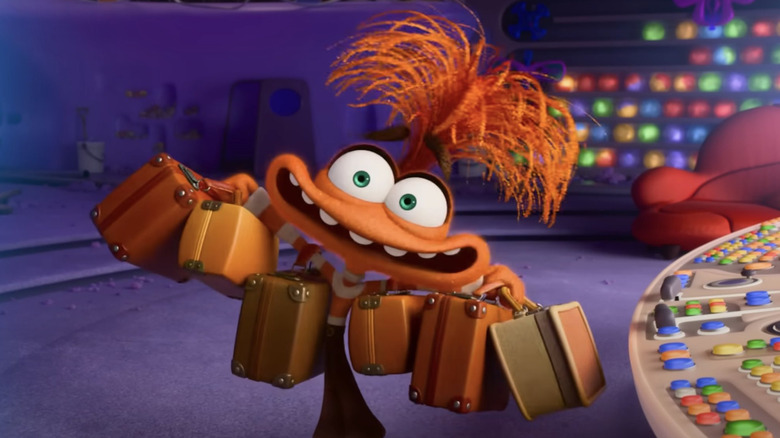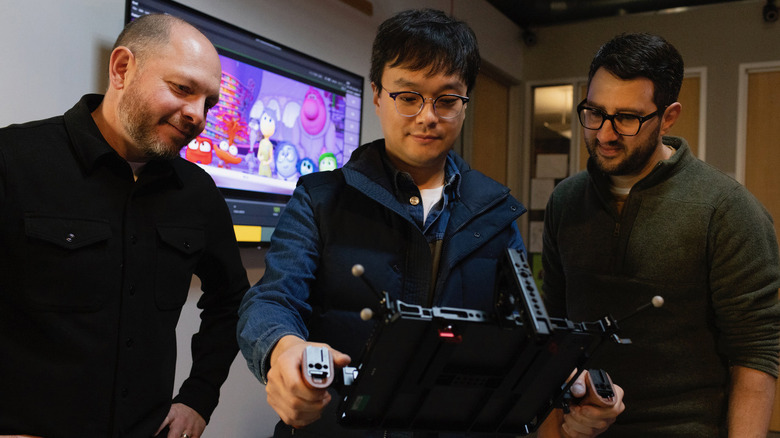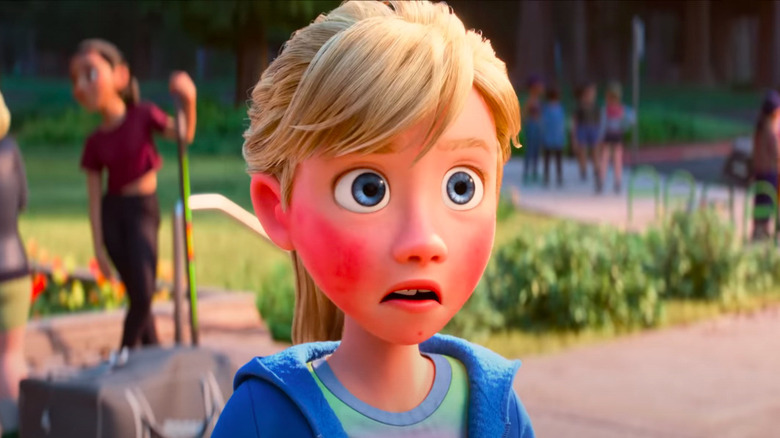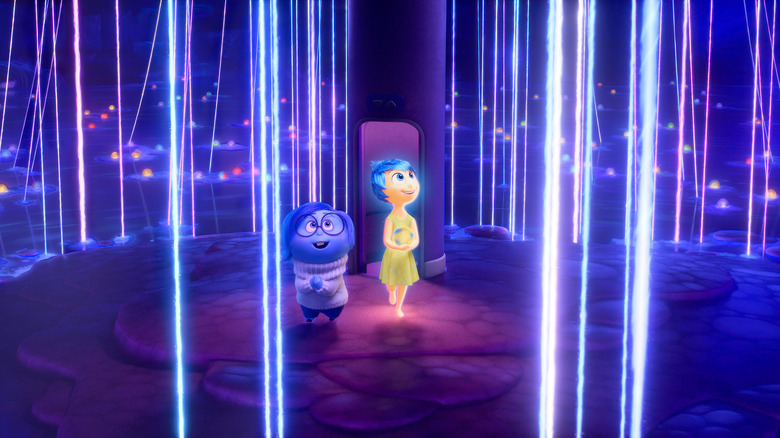How Pixar's Inside Out 2 Took Surprising Inspiration From An Adam Sandler Movie
Back in March, Pixar Animation invited /Film to check out 35 minutes of their upcoming animated sequel "Inside Out 2." Along with the screening of the film's promising, clever, and hilarious first act, a series of presentations from the many filmmakers working on the movie took us behind the scenes to learn all about how the next chapter of Riley's life came together.
In "Inside Out 2," the core emotions find themselves overwhelmed when the now 13-year-old Riley enters puberty and begins experiencing some new emotions. Joy (Amy Poehler), Sadness (Phyllis Smith), Anger (Lewis Black), Fear (Tony Hale, replacing Bill Hader), and Disgust (Liza Lapira, replacing Mindy Kaling) are confronted with some drastic changes in how Riley approaches life when Anxiety (Maya Hawke), Envy (Ayo Edebiri), Ennui (Adèle Exarchopoulos), and Embarrassment (Paul Walter Hauser) show up and start messing with the console inside their girl's min.
Acting as the leader of the new emotions, Anxiety is the one who creates the biggest concern for Joy, as this complex new emotion threatens to upend Riley's belief system and sense of self, two new important parts of Riley's personality that the core emotions have worked very hard to maintain. With Anxiety being such a key part of the story, it should come as no surprise that her presence influenced how Riley was portrayed in the movie, not just as a character, but in the animated movie's cinematography. In fact, as director of photography Adam Habib revealed to us, a certain Adam Sandler movie served as a surprising inspiration to their visual approach when Anxiety was in control of Riley's mind console.
'We do things like use handheld in the movie when Anxiety is driving'
While at Pixar Animation, cinematographer Adam Habib (seen above right with layout leads Ryan Heuett, left, and Sunguk Chun, middle) showed off a virtual camera rig that is used to shoot within animated environments. Yes, even though the film is animated, it can still be shot as if there was a camera moving within the animated world. More often than not, they won't create any shots that they otherwise wouldn't be able to get if they were shooting on a real-life, practical set, to ensure there's still a sense of realism that keeps the audience grounded. It also allows them to create various vibes, depending on how characters and environments are captured, both with various lenses and camera movements.
Since Anxiety plays such a key role in "Inside Out 2," the filmmakers wanted to make sure that the visual language of the movie represented her presence when she was in control of the console. Habib said:
"We have this really fun new element with the character of Anxiety, and when Anxiety is driving, as you know when you feel it, the world feels really different. So we try to represent that visually. We do things like use handheld in the movie when Anxiety is driving."
For inspiration on how to do this, they looked to "Uncut Gems," the stressful Safdie Bros. movie starring Adam Sandler that is packed with anxiety and tension (and also has the seventh most f-bombs in any movie ever made). Habib explained how the movie influenced their camera work:
"We were thinking about movies that show anxiety really well, and one of them for me from the last few years was 'Uncut Gems.' I don't know if you know this about 'Uncut Gems,' but they made a rule for themselves that when he's in the front of the showroom and he's kind of presenting and he's in his showman role, they use Steadicam. But when they go to the back of the office, and these guys are trying to get money out of him and stuff, they use handheld. So that's where the inspiration [came from], 'Okay, when anxiety is driving, maybe we're using handheld specifically for those moments."
'We try to get the weight and physics of a real camera'
Habib pointed out a specific example of where you can see this visual style executed. There's a scene in the movie, which you can see briefly in the trailer, where Riley has an awkward moment meeting Valentina 'Val' Ortiz (Lilimar Hernandez), the star player of the Firehawks high school hockey team that Riley hopes to join. Riley has great admiration for Val, but she gets a little anxious when they meet, as she's eager to make a good impression. In that scene, the animators provided a fully animated 360-degree space for the camera to move around in. Habib explained:
"When Riley meets Valentina, we actually operate a virtual camera like this after the shot has been animated to capture that feeling like everything is a little bit unsteady or like not quite as smooth as it was before. We try to get the weight and physics of a real camera. So those are kinds of things that are important to us to ground the audience."
Strangely enough, "Uncut Gems" wasn't the only Adam Sandler movie that influenced "Inside Out 2." Would you believe that Paul Thomas Anderson's "Punch-Drunk Love" also had a hand in shaping another part of the animated sequel?
The belief system and Punch-Drunk Love
One of the new developments inside Riley's mind since we met her in the original "Inside Out" is an entire belief system that is sourced from various memories over the years. Far down in the root of Riley's mind, an elevator takes the core emotions down to the belief system, where the memory orbs from the first movie feed a variety of beliefs, everything from her favorite band to the fact that homework should be illegal. But more importantly, it fuels beliefs like the fact that she's a really good friend.
The belief system (seen above) is visualized by an abstract space where the memory orbs sit in a large pool, with strings that float down and connect to the memories in the water. Those strings connect to a small, ethereal sort of statue up in headquarters that helps form Riley's sense of self. It's this space where filmmakers took inspiration from Paul Thomas Anderson's "Punch-Drunk Love," a peculiar romance starring Adam Sandler. When asked if there was a certain "Inside Out 2" set that was particularly satisfying to work in creatively, Adam Habib cited the belief system and went on to reveal how Paul Thomas Anderson's visuals helped shape the new location:
"For me, I would say the belief system was a really cool set. On one hand, it feels really simple, it's just this very long set of strings. But within those strings, you could always find such interesting compositions. For this shot, I remember [director] Kelsey [Mann] was talking about a shot from 'Punch-Drunk Love,' the Adam Sandler movie. I don't know if you remember, but there are these shots that are really out of focus and are just colors. So we had a lot of fun creating that, just out of these strings and the shots in the movie where you kind of rack focus through. It was a cool set, because there were almost endless ways that you could shoot this really simple space."
If you've never seen "Punch-Drunk Love," you should rectify that immediately, especially since it's an unlikely companion piece to "Uncut Gems." But for those curious about the visuals, you can see the sequence that helped inspire what Habib is talking about above.
You'll be able to see the belief system in full yourself when "Inside Out 2" hits theaters on June 14, 2014.



